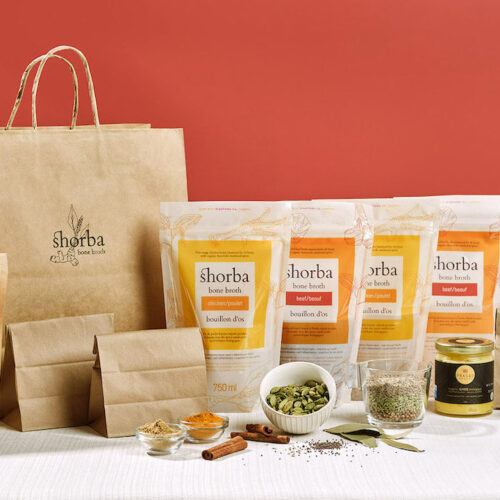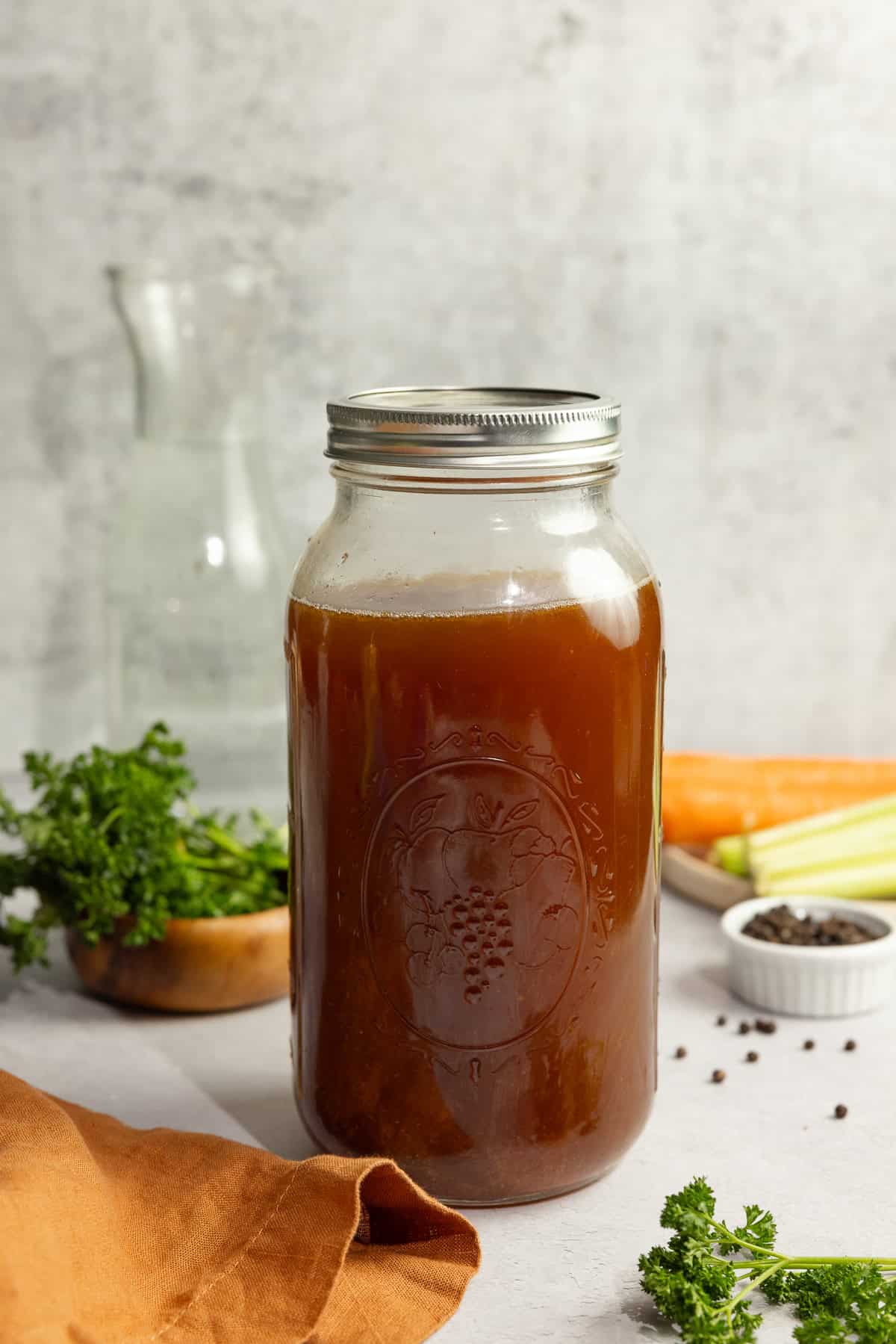Why Bone Broth Vancouver Is Gaining Traction Among Nutrition Experts
Wiki Article
Exactly How to Make Beef Bone Broth: A Step-by-Step Guide for Delicious Homemade Nutrition
Beef bone broth is a healthy addition to any kitchen area. It supplies various wellness benefits and can improve a variety of meals. The process begins with choosing the appropriate bones and ingredients. Recognizing each step is vital for attaining the very best flavor and splendor. Many home chefs forget important methods that can raise their brew. What are these techniques, and exactly how can they transform a basic broth into a cooking staple?Comprehending the Benefits of Beef Bone Broth
While lots of people delight in the abundant taste of beef bone brew, they may not totally appreciate its numerous wellness benefits. This beneficial elixir is known for its high collagen material, which supports joint health and wellness and promotes skin flexibility. The amino acids discovered in bone brew, such as glycine and proline, play substantial duties in muscle mass repair work and gastrointestinal health and wellness. In addition, it is rich in minerals like magnesium, calcium, and phosphorus, necessary for keeping strong bones and general well-being. Bone broth likewise has anti-inflammatory properties, which can minimize signs and symptoms connected with persistent problems. Consuming it might support gut wellness by boosting the mucosal lining of the digestive system, advertising better nutrient absorption. The heat and convenience of a steaming dish of broth can offer a soothing result, making it a scrumptious and healthy option for individuals seeking both cooking pleasure and health advantages. Cooking Choosing the Right Bones The structure of a nutritious and savory beef bone brew depends on the option of bones. For optimal results, it is necessary to select a range of bones that supply a rich mix of taste and nutrients. Marrow bones, which have the fatty, gelatinlike marrow, are especially valued for their capability to enhance the brew's richness. Joint bones, such as knuckles and oxtails, are also helpful because they are high in collagen, contributing to a smooth appearance. Additionally, including some weighty bones can include depth to the taste account. Sourcing bones from grass-fed or pasture-raised livestock is advisable, as these options tend to use premium high quality and preference. It is likewise important to identify the bones are fresh and cost-free from any repulsive smells. By meticulously selecting the best bones, one can prepare for a beneficial and scrumptious beef bone broth.Necessary Components for Flavorful Brew
To create a flavorful beef bone brew, choosing high quality beef bones is vital as they serve as the foundation of the recipe - Bone Broth Vancouver. Aromatic vegetables and a careful option of flavors and herbs better boost the brew's depth and intricacy. Together, these essential components add to a rich and rewarding taste profile
Top Quality Beef Bones
Quality beef bones act as the structure for a rich and tasty brew. The most effective choices consist of marrow bones, knuckle bones, and oxtails, each adding distinct appearances and flavors. Marrow bones are treasured for their jelly material, which aids produce a smooth mouthfeel. Knuckle bones, abundant in collagen, boost the brew's body and dietary account. Oxtails supply a passionate preference and added richness. It is essential to source bones from grass-fed or pasture-raised cattle, as this improves the overall high quality and flavor of the broth. Quality is also important; bones must be used within a couple of days of acquisition or frozen for later usage. Choosing high-quality beef bones guarantees a nourishing and scrumptious final item.Fragrant Vegetables Option
While selecting fragrant veggies, one must take into consideration the function they play in enhancing the total flavor account of the beef bone broth. Common choices consist of onions, carrots, and celery, often described as the "mirepoix." Onions include sweetness and depth, while carrots contribute a refined earthiness. Celery provides a revitalizing clarity that balances the splendor of the brew. Garlic, though optional, can introduce a robust flavor, complementing the full-flavored notes of the beef. Leeks and shallots are likewise superb additions, offering special preference measurements. For a hint of heat and intricacy, some might consist of ginger or fennel. Selecting a mix of these aromatic vegetables assures a tasty and versatile broth, setting the structure for a beneficial culinary experience.Flavorful Herbs and Spices
Incorporating delicious herbs and seasonings is important for boosting the taste of beef bone broth, as they present aromatic intricacy and depth. Usual selections include bay leaves, which present a refined natural note, and thyme, recognized for its earthy taste. Rosemary, with its pine-like significance, includes a rejuvenating touch, while parsley adds illumination and freshness. For a hint of heat, black peppercorns and garlic are excellent enhancements, boosting the broth's general splendor. Furthermore, pepper flakes or chili powder can introduce a gentle warm for those that choose a little bit of flavor. Choosing a balanced mix of these ingredients not just boosts flavor however also instills the brew with useful nutrients, making it a scrumptious and nourishing option for any type of meal.Preparing the Bones and Vegetables
To develop a flavorful and rich beef bone brew, the prep work of vegetables and bones is essential. Choosing top notch beef bones, such as marrow, oxtail, or knuckle, is important, as they give the necessary collagen and nutrients. Roasting the bones in the oven improves their taste, giving the broth a much deeper, richer taste. It is recommended to roast them at 400 ° F for regarding half an hour, until browned.Next, vegetables play a critical role in building taste. Usual options consist of onions, carrots, and celery, known as the mirepoix base. These ought to be roughly chopped to optimize taste extraction throughout simmering. Garlic and tomatoes can also be consisted of for added depth.Lastly, rinsing the vegetables and bones under chilly water helps remove any kind of impurities, ensuring a clear brew. Effectively preparing bones and vegetables establishes the structure for a delicious and beneficial beef bone brew.Cooking Methods: Stovetop vs. Slow Stove
When it involves cooking beef bone broth, the choice in between stovetop and sluggish cooker methods presents distinctive advantages. Stovetop cooking allows for quicker results and even more control over the simmering process, while slow-moving cookers offer ease and an extended infusion of flavors. Each approach has its one-of-a-kind benefits, accommodating different choices and routines.
Stovetop Cooking Conveniences
While both stovetop and slow stove methods have their qualities, stovetop cooking offers special advantages that can enhance the procedure of making beef bone brew. One significant advantage is the ability to regulate the temperature level and simmering time extra specifically, which can result in perfect removal of nutrients and tastes from the bones. Furthermore, stovetop food preparation enables real-time changes, enabling the chef to keep track of the brew's uniformity and taste throughout the process. The quicker cooking time compared to slow down stoves can additionally be beneficial for those needing brew in a shorter duration. The stovetop method urges a hands-on strategy, fostering a deeper link to the food preparation procedure and possibly resulting in an extra savory end item.Slow Stove Advantages
Making use of a slow-moving stove for making beef bone broth uses a number of unique advantages that attract several home cooks. One primary advantage is the comfort of set-it-and-forget-it food preparation. Once the active ingredients are integrated, the slow-moving stove can operate ignored for hours, enabling a busy schedule without constant monitoring. In addition, slow-moving stoves keep a constant low temperature, which draws out flavors and nutrients properly over time without the threat of steaming, resulting in a richer broth. The power performance of sluggish stoves additionally attracts attention, as they utilize less electricity contrasted to stovetops (Bone Broth Vancouver). Additionally, slow-moving stoves typically have programmable settings, making it possible for exact control over cooking times, which improves the overall simplicity of broth prep workStressing and Keeping Your Brew
Straining and saving beef bone brew is an essential action that assures a clear, tasty last product. As soon as the broth has simmered for the advised time, it ought to be you can look here carefully poured via a great mesh strainer or cheesecloth into a huge bowl or pot. This process eliminates any kind of solids, such as meat, vegetables, and bones, guaranteeing a smooth uniformity. To capture all taste, pressing the solids carefully with a spoon can be beneficial.After straining, the brew needs to cool down to room why not try these out temperature before being saved. It is best to utilize impermeable containers, such as glass containers or freezer-safe bags, to avoid freezer maintain and burn freshness. Identifying the containers with the date is likewise suggested. The brew can be refrigerated for as much as a week or iced up for several months, making it a practical addition to future dishes. Proper storage guarantees that the nutritional benefits and tastes stay undamaged.Creative Ways to Make Use Of Beef Bone Broth
Beef bone broth uses a functional structure for a variety of dishes, enhancing both flavor and nutrition. Home cooks can integrate it into soups and stews, giving an abundant base that strengthens the general preference. It can also be utilized as a cooking liquid for grains, such as rice or quinoa, infusing them with added nutrients and flavor.Additionally, beef bone brew works as an outstanding structure for sauces and gravies, offering intricacy and splendor to dishes. For those seeking a healthy beverage, drinking cozy brew can be nourishing and relaxing. It can also be made use of in smoothies for a healthy protein increase, though this might need some innovative flavor balancing.Ultimately, beef bone broth not just boosts daily recipes however also adds to a wholesome diet regimen, making it a staple component for health-conscious people and cooking lovers alike.Frequently Asked Questions
How Much Time Can I Shop Beef Bone Broth in the Fridge?
The concern of storage space duration for beef bone brew in the refrigerator is very important. Typically, it can be securely kept for about 3 to 5 days, guaranteeing quality and high quality prior to consumption or cold for longer preservation.
Can I Freeze Beef Bone Brew, and for How Long?
Beef bone brew can be frozen effectively, enabling prolonged storage space. When appropriately sealed in impermeable containers, it can last as much as 6 months in the freezer, maintaining its taste and dietary benefits for later use.Is It Safe to Make Use Of Bones From a Grocery Store?
The safety and security of using supermarket bones relies on their resource and handling. If properly sourced and kept, these bones can be safe for usage, providing necessary nutrients when prepared appropriately for broth.Can I Make Beef Bone Brew in an Instantaneous Pot?
The Immediate Pot is indeed appropriate for making beef bone brew - Bone Broth Near Me. Its pressure food preparation feature significantly lowers cooking time while still extracting abundant tastes and check these guys out nutrients, making it a hassle-free option for busy home chefs
What Nutritional Differences Exist In Between Beef and Hen Bone Brew?
The nutritional differences between beef and chicken bone broth mainly exist in their collagen web content, amino acids, and mineral accounts. Beef brew typically includes even more collagen and minerals, while chicken broth is frequently lighter and much easier to absorb. The foundation of a delicious and nourishing beef bone broth lies in the selection of bones. To create a tasty beef bone brew, picking top quality beef bones is essential as they offer as the structure of the recipe. The best options include marrow bones, knuckle bones, and oxtails, each adding one-of-a-kind textures and tastes. While picking fragrant veggies, one need to take into consideration the function they play in enhancing the overall flavor account of the beef bone brew. To produce a savory and abundant beef bone brew, the prep work of vegetables and bones is vital.Report this wiki page